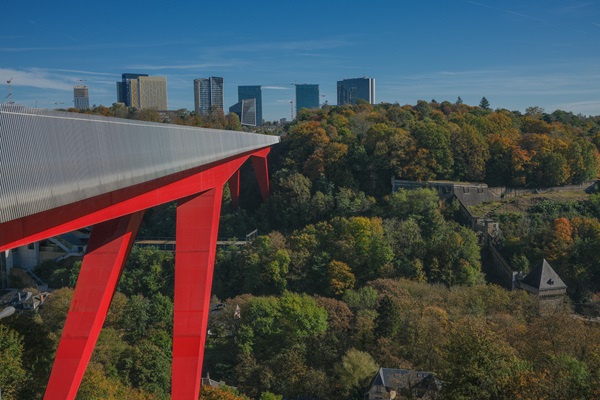 the Red Bridge;
Credit: Ali Sahib
the Red Bridge;
Credit: Ali Sahib
As an open and outward-looking country, Luxembourg often talks about “building bridges” with its partners and with other countries; it is also home to an array of actual bridges - 1,271 as of 2021.
In this series of articles, Chronicle.lu will offer an overview of a selection of bridges scattered across the Grand Duchy. This article (Part 1 of 2) looks at historic bridges.
Some of Luxembourg’s many bridges are admired for their architectural beauty, others have stood the test of time and witnessed some darker periods in the country’s history, including occupation by Nazi Germany during World War II. The German invasion began with the 1st, 2nd and 10th Panzer Divisions crossing the border at Wallendorf-Pont, Vianden and Echternach. The Germans used wooden ramps to bypass tank traps on the Schuster Line (a series of fortifications and defensive positions built by Luxembourg in the late 1930s). Although fire was exchanged, they faced minimal resistance, encountering only some destroyed bridges and land mines, as most of the Luxembourgish Volunteer Corps remained in their barracks. A small group of Germans secured the bridge at Wormeldange, capturing two customs officers without a fight. The partially demolished bridge over the Sûre at Echternach was then swiftly repaired by engineers from the Großdeutschland regiment, facilitating the advance of the 10th Panzer Division.
Bridges thus have historic and strategic significance. They are also border markers (similar to natural borders such as rivers). Luxembourg has several cross-border bridges, for example the steel bridge across the Moselle linking Grevenmacher (Luxembourg) to Wellen (Germany), inaugurated in October 2013. It has a total length of 213 metres and it replaced its concrete predecessor built in 1955.
Among the best-known historic bridges are:
- Pont Adolphe (Adolphe bridge), also known as the Pont Neuf (new bridge): a 153 m long stone arch bridge built between 1900 and 1903, under the reign of Grand Duke Adolphe. Its large double arch overlooks the Pétrusse valley at a height of 42 metres. On Luxembourg’s National Day eve, on 22 June at 23:00, there is a spectacular fireworks display above this bridge. In 2018, a lower deck was added beneath the upper structure, featuring a dedicated bidirectional bicycle path, with pedestrian access. This cycle bridge under the Adolphe bridge is the first bridge in the world to be suspended in this manner. Named after Grand Duke Adolphe, the bridge symbolises Luxembourg’s independence and has evolved into a prized national architectural landmark, depicted on numerous postcards, paintings and drawings as well as souvenirs.
- Pont Grande-Duchesse Charlotte or the Grand Duchess Charlotte Bridge, named in honour of Grand Duchess Charlotte of Luxembourg, who inaugurated the bridge in 1966, is widely known as the Red Bridge thanks to its paintwork. It connects the city centre to the Kirchberg European district, over the Pfaffenthal valley. It is 355 metres long and 25 metres wide, weighing a total of 4,900 tonnes. The bridge has a tragic history of suicides – there are reports of many people having jumped off this bridge. Between 1966 and 1992, official figures stood at about 100 suicides (1 suicide every 3 months for 26 years). Luxembourgish filmmaker Geneviève Mersch raised awareness of the issue in her 1991 documentary Le Pont Rouge, shown at various international festivals. The film follows the daily lives of families who lived under the Red Bridge and features interviews about dark discoveries made in their gardens… One year later, the Luxembourg Government decided to set up acrylic glass security barriers on the bridge to prevent further suicides. These were upgraded to a height of 2.7 metres in 2017. Some suicide attempts continued.
The bridge has a batter-post rigid-frame design, with its inclined legs varying in length, lending a sense of dynamic geometry to its profile. Over the years, the Red Bridge has undergone maintenance and enhancements, including resurfacing in the 1980s and a fresh coat of paint in 1989. Between 2015 and 2018, major structural works were carried out to accommodate the tram. The bridge was widened, the railings were replaced, the road surface was reinforced and two tramway tracks were added.
- Passerelle/Vieux Pont, also known as the Viaduct bridge or (in Luxembourgish) the Al Bréck (old bridge), runs from the south to the city centre (Ville Haute), over the Pétrusse valley (at a height of 45 metres). Built between 1859 and 1861, it boasts 24 arches and a total length of 290 metres. A new higher railing was installed at the Passerelle bridge in 2020. Renovations included adding dedicated cycling and pedestrian paths, widening the bridge, and installing platforms supported by pillars anchored to the original structure. Additionally, an extra bus lane was incorporated to maintain bus traffic while keeping the existing traffic lanes operational.
- Bisser Bréck or the Pulvermuhl Viaduct is a historic, two-track railway viaduct that connects the city centre to the district of Pulvermuhl; it has a length of 242 metres and is approximately 37 metres tall. It was opened along with the railway track in 1862 and has been electrified since 1988. The bridge was expanded in recent years.
- Béinchen is a stone footbridge, a UNESCO World Heritage Site which forms part of the old fortress in Luxembourg-Pfaffenthal. It was built between 1684 and 1685, based on Vauban’s design. Three small arches connect the valley between the towers of the gates of Eich and the Val des Bons-Malades.
The list continues in Part 2.








